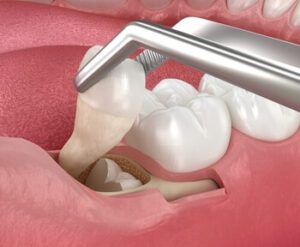If you have ever wondered about removing root canal tooth, you are not alone. Root canal treatment can save many teeth, but sometimes, a root canal-treated tooth can cause ongoing problems. In certain situations, extracting a tooth that has already been treated becomes the best option for maintaining long‑term oral health. This article will guide you through why and when removing a root canal tooth might be necessary and what you can expect from the procedure.
Understanding the Role of Root Canal Treatment
Root canal procedure is designed to save a damaged or infected tooth by removing the infected pulp and sealing the canal with a specific root canal filling material. This treatment can save a tooth that might otherwise be lost, allowing it to remain in place and continue to function naturally. However, even a root canal-treated tooth can sometimes develop recurrent infections or other complications. When this occurs, removing root canals may be required to protect your overall oral health.
Why Might a Root Canal Tooth Need to Be Removed?
- Recurrent infections: Sometimes, a root canal infection can return if bacteria remain inside the root canal or seep in later.
- Severe damage: A tooth can become severely damaged from trauma, decay, or cracking that cannot be repaired with further treatment.
- Infected or damaged tissue: When an infected tooth causes ongoing discomfort despite a root canal, extracting the tooth may be the best option.
- Systemic disease or health concerns: Certain medical conditions can affect how your body heals. In some instances, removing root canals may be suggested for patients with systemic disease or other health conditions.
In such cases, extracting the root canal tooth can reduce the risk of further decay, recurrent infections, and serious complications that could affect overall health.
The Extraction Process: What to Expect
Removing root canals and extracting the treated tooth is a routine procedure performed in a dental clinic. The tooth is carefully and precisely removed from its socket, making sure the surrounding tissues, bone, and gum tissue are preserved as much as possible. Here is an overview of the extraction process:
Numbing the area: Using a local anaesthetic, your dentist will ensure you stay comfortable throughout the procedure.
Loosening the tooth: Certain instruments are used to gently separate the tooth from its root and the surrounding bone and gum tissue.
Careful extraction: The root canal-treated tooth is then removed with precision, ensuring that the adjacent teeth and surrounding tissues are not damaged.
Managing the extraction site: The site will be cleaned thoroughly to remove any infected or damaged tissue. Sometimes, a platelet-rich fibrin material can be used to support healing and reduce the risk of dry socket and bone loss.
Post‑extraction care: A blood clot forms naturally in the area, aiding the healing process. Patients are advised to stick to soft foods and maintain a clean oral environment to support proper healing of the site.
What Happens After Removing a Root Canal Tooth?
Once the tooth has been removed, your dentist will discuss the next steps and any further treatment options with you. These might include:
- Dental implant: An implant can replace the extracted tooth, preserving bone and gum tissue and restoring a natural, functional smile. Zirconia implants are an option for patients seeking a metal‑free solution.
- Partial dentures: In cases where an implant is not suitable, a partial denture can fill the gap and support adjacent teeth.
- Additional treatments: Sometimes, further treatments are needed to ensure long‑term health, especially if bone loss or damage to the surrounding tissue has occurred.
Your dentist will consider various factors when advising the best approach, including your overall oral health, risk of systemic disease, and other medical or health concerns.
The Importance of Maintaining Oral Health After an Extraction
- Avoid disturbing the blood clot
- Follow a soft food diet
- Maintain good oral hygiene
- Attend follow‑up appointments
- Stay alert for signs of infection or discomfort
Proper care will aid recovery, reduce the risk of complications and support bone and gum tissue health.
Considering Your Overall Health and Making an Informed Decision
Tooth extraction is a serious decision. It affects not only your oral health but can also have a huge impact on your overall health and well‑being. Chronic infections or failed root canals can be linked to systemic disease, making timely intervention an important consideration.
By removing a root canal-treated tooth when necessary, you can lower the risk of serious complications such as heart disease and other health conditions that arise from long‑standing infections. Patients with systemic disease or long‑standing medical concerns may find value in a holistic approach that considers both their oral and overall health.
Seeking Advice From a Dental Professional
With advances in dental procedures and treatments, you can now expect a comfortable experience that prioritises both your oral health and overall well‑being.
Final Thoughts
Root canal treatments save countless teeth every year, but sometimes, removing root canal tooth is necessary for long‑term health. Chronic infections, severely damaged teeth, and concerns about systemic disease can make tooth extraction the best option. Whatever the reason, extracting a root canal treated tooth can reduce the risk of further decay, recurrent infections, and complications that can affect both oral and overall health.
Today’s dental procedures ensure that tooth extraction is safe, comfortable, and performed with precision. By choosing a trusted dental clinic and discussing the available treatments for a missing tooth, you can restore your smile, maintain the health of your surrounding teeth and gum tissue, and move forward with confidence and comfort.
If you have questions or concerns about removing root canals, contact us to book an appointment with Balmoral Dental Centre at (07) 3113 9789 for expert advice and care.
Note: Any surgical or invasive procedure carries risks. Before proceeding, you should seek a second opinion from an appropriately qualified health practitioner.
References
- American Association of Endodontists. (n.d.). What is a root canal? Retrieved from https://www.aae.org/patients/root-canal-treatment/what-is-a-root-canal/
- Colgate. (n.d.). What is good oral hygiene? Retrieved from https://www.colgate.com/en-us/oral-health/adult-oral-care/what-is-good-oral-hygiene
Healthline. (n.d.). Dental anesthesia: What to expect and types used. Retrieved from https://www.healthline.com/health/dental-and-oral-health/dental-anesthesia




